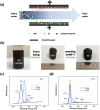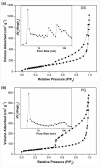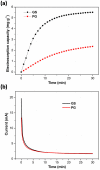Facile synthesis of novel graphene sponge for high performance capacitive deionization
- PMID: 25675835
- PMCID: PMC4327409
- DOI: 10.1038/srep08458
Facile synthesis of novel graphene sponge for high performance capacitive deionization
Abstract
Capacitive deionization (CDI) is an effective desalination technique offering an appropriate route to obtain clean water. In order to obtain excellent CDI performance, a rationally designed structure of electrode materials has been an urgent need for CDI application. In this work, a novel graphene sponge (GS) was proposed as CDI electrode for the first time. The GS was fabricated via directly freeze-drying graphene oxide solution followed by annealing in nitrogen atmosphere. The morphology, structure and electrochemical performance of GS were characterized by scanning electron microscopy, Raman spectroscopy, nitrogen adsorption-desorption, X-ray photoelectron spectroscopy, cyclic voltammetry and electrochemical impedance spectroscopy. The electrosorption performance of GS in NaCl solution was studied and compared with pristine graphene (PG). The results show that due to the unique 3D interconnected porous structure, large accessible surface area and low charge transfer resistance, GS electrode exhibits an ultrahigh electrosorption capacity of 14.9 mg g(-1) when the initial NaCl concentration is ~500 mg L(-1), which is about 3.2 times of that of PG (4.64 mg g(-1)), and to our knowledge, it should be the highest value reported for graphene electrodes in similar experimental conditions by now. These results indicate that GS should be a promising candidate for CDI electrode.
Figures








Similar articles
-
Novel nitrogen doped graphene sponge with ultrahigh capacitive deionization performance.Sci Rep. 2015 Jun 11;5:11225. doi: 10.1038/srep11225. Sci Rep. 2015. PMID: 26063676 Free PMC article.
-
Enhanced capacitive deionization performance of graphene by nitrogen doping.J Colloid Interface Sci. 2015 May 1;445:143-150. doi: 10.1016/j.jcis.2015.01.003. Epub 2015 Jan 9. J Colloid Interface Sci. 2015. PMID: 25617614
-
Electrospun carbon nanofibers reinforced 3D porous carbon polyhedra network derived from metal-organic frameworks for capacitive deionization.Sci Rep. 2016 Sep 9;6:32784. doi: 10.1038/srep32784. Sci Rep. 2016. PMID: 27608826 Free PMC article.
-
Electrosorption performance on graphene-based materials: a review.RSC Adv. 2023 Feb 24;13(10):6518-6529. doi: 10.1039/d2ra08252g. eCollection 2023 Feb 21. RSC Adv. 2023. PMID: 36845580 Free PMC article. Review.
-
Performance metrics for the objective assessment of capacitive deionization systems.Water Res. 2019 Apr 1;152:126-137. doi: 10.1016/j.watres.2018.10.074. Epub 2018 Nov 12. Water Res. 2019. PMID: 30665159 Review.
Cited by
-
Turning waste into valuables: In situ deposition of polypyrrole on the obsolete mask for Cr(VI) removal and desalination.Sep Purif Technol. 2023 Feb 15;306:122643. doi: 10.1016/j.seppur.2022.122643. Epub 2022 Nov 14. Sep Purif Technol. 2023. PMID: 36406342 Free PMC article.
-
Novel nitrogen doped graphene sponge with ultrahigh capacitive deionization performance.Sci Rep. 2015 Jun 11;5:11225. doi: 10.1038/srep11225. Sci Rep. 2015. PMID: 26063676 Free PMC article.
-
Ultrahigh Performance of Novel Capacitive Deionization Electrodes based on A Three-Dimensional Graphene Architecture with Nanopores.Sci Rep. 2016 Jan 5;6:18966. doi: 10.1038/srep18966. Sci Rep. 2016. PMID: 26727988 Free PMC article.
-
Rocking Chair Desalination Battery Based on Prussian Blue Electrodes.ACS Omega. 2017 Apr 26;2(4):1653-1659. doi: 10.1021/acsomega.6b00526. eCollection 2017 Apr 30. ACS Omega. 2017. PMID: 31457530 Free PMC article.
-
Microwave-Assisted Synthesis of Highly-Crumpled, Few-Layered Graphene and Nitrogen-Doped Graphene for Use as High-Performance Electrodes in Capacitive Deionization.Sci Rep. 2015 Dec 8;5:17503. doi: 10.1038/srep17503. Sci Rep. 2015. PMID: 26643279 Free PMC article.
References
-
- Yang Z. Y. et al. Sponge-templated preparation of high surface area graphene with ultrahigh capacitive deionization performance. Adv. Funct. Mater. 24, 3917–3925 (2014).
-
- Yin H. et al. Three-dimensional graphene/metal oxide nanoparticle hybrids for high-performance capacitive deionization of saline water. Adv. Mater. 25, 6270–6276 (2013). - PubMed
-
- Wen X., Zhang D., Yan T., Zhang J. & Shi L. Three-dimensional graphene-based hierarchically porous carbon composites prepared by a dual-template strategy for capacitive deionization. J. Mater. Chem. A 1, 12334–12344 (2013).
-
- Garcia-Quismondo E. et al. New testing procedures of a capacitive deionization reactor. Phys. Chem. Chem. Phys. 15, 7648–7656 (2013). - PubMed
-
- Hojati-Talemi P., Zou L., Fabretto M. & Short R. D. Using oxygen plasma treatment to improve the performance of electrodes for capacitive water deionization. Electrochim. Acta 106, 494–499 (2013).
LinkOut - more resources
Full Text Sources
Other Literature Sources

